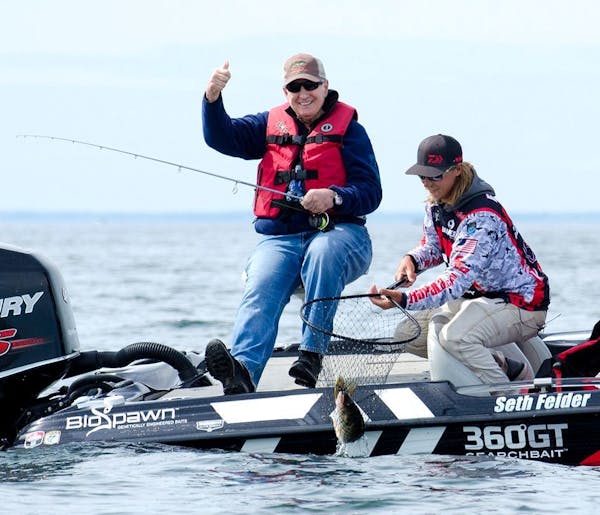Two days after his fishing trip was interrupted by a protest flotilla on Lake Mille Lacs, Gov. Mark Dayton said the state will conduct a walleye survey of the lake and possibly ease the fishing restrictions that prompted the demonstration.
The state Department of Natural Resources will sample the walleye population this fall, Dayton said Monday. If the fish are thriving, as critics of the restrictions say they seem to be, the state would revisit its regulations and catch limits on the popular lake.
Dayton said he's hoping that the survey will back up local reports that a healthy population of walleye is back and biting on Mille Lacs, one of the state's premier walleye fishing destinations.
More than 25 boats carrying protesters circled the governor's boat as he fished for bass on Saturday. The demonstrators were holding up signs and protesting a three-week temporary ban on walleye fishing on the lake that began July 7.
The state and the Mille Lacs Band of Ojibwe, who jointly manage the fishery, said the restriction was needed to protect the health of the spawning walleye population.
But local resort owners said that the shutdown was unnecessary and that it is damaging businesses throughout the region.
"The frustration has been building for years," said Linda Eno, owner of the Twin Pines Resort in Garrison, Minn., and an organizer of the protest. "The governor was coming, and we thought it was a good time to show our discontent."
Walleye fishing on Mille Lacs has been increasingly restricted in recent years, with smaller keeper limits and a new rule of no live bait allowed. This year's three-week shutdown was the last straw, Eno said.
"The social fabric of our area has been decimated," she said. "Over 50 businesses on the lake have closed in recent years. People who loved this lake from around the state have stopped coming and started new traditions, and it's going to be difficult to get them back."
Dayton traveled to Mille Lacs on Saturday to fish for bass and to meet with local residents to discuss the ban. After the protest, he canceled the meeting, but local business owners said they expect it to be rescheduled for sometime in the next week.
Dayton called the protest "unfortunate. Because we were up there to promote the virtues of Mille Lacs — the No. 1 bass fishing lake in the country, excellent muskie fishing.
"I totally understand and respect the distress so many people have experienced there, in their businesses and their way of life in the past couple of years," he said. "Hopefully, the anecdotal [report] of more walleye in the lake is evidence we are turning the corner here, and I hope and believe that will be the case."
DNR Commissioner Tom Landwehr declined to comment Monday on the protest and its aftermath. Officials of the Mille Lacs Band did not return phone calls.
Each year, the state and the tribe agree on a quota of walleye, measured in pounds, that can be taken from the lake. This year's quota is about 64,000 pounds, split 70/30 between state-licensed anglers and the Ojibwe band. That means about 45,000 pounds total for state-licensed anglers, who already caught 14,000 pounds during the winter ice-fishing season.
Anglers also caught too many walleye last summer, and so this year's harvest will be reduced to account for that. When all of the math is done, anglers are limited to 29,000 pounds of Mille Lacs walleye this summer, the lowest total ever. Decades ago, anglers took as many as 600,000 pounds of walleye from the lake in a season.
Eddy Lyback, who runs a boat dealership and an ice-fishing outfitter near Isle, Minn., said the current management agreement between the state and the band needs to be changed.
"I point the finger directly back to this whole co-management system to basically micromanage a few thousand pounds of fish," he said. "It's just not working."
Lyback, who has fished and worked on the lake for more than 40 years, said the methods used to measure the fish population aren't accurate. Those who live on the lake have a better idea of conditions than scientists who take a sample, he said. "Based on what people are seeing and how they're biting, there are a lot of walleyes out there," he said.
And the state's hope that Mille Lacs will become a premier destination for smallmouth bass — it was recently ranked the No. 1 bass lake in the nation by Bassmaster magazine — won't make up for the decline in walleye fishing.
"Walleye fishermen and bass fishermen are two different kinds of fishermen," Lyback said. "Walleye fishermen tend to stay a couple of days. They bought bait. They'd go to restaurants. They put a little more money in the area.
"Bass fishermen, by the time they show up, they have everything they need in their tackle box."
John Reinan • 612-673-7402
Jennifer Brooks • 612-673-4008

Four Minnesotans catch salmonella in outbreak linked to basil sold at Trader Joe's

Rep. Omar's daughter arrested, suspended from college for pro-Palestinian protests
Hopkins parents charged in 9-year-old daughter's asthma death

Back to blue: Lake Harriet Band Shell renovation almost finished

